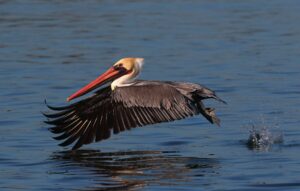The story begins in Arizona, when I was working as a biological science technician on a northern goshawk demography study. My job involved identifying banded birds, and that meant rising before dawn and hanging around nest areas, waiting for a prey delivery. Often I’d scope an elusive male’s anklet by 8 a.m., then recline in the duff at the foot of a ponderosa pine for some quick shut-eye.A few times, I woke with a start to a huge raptor perched on a nearby branch, its crimson eyes lasering me. Whoa! Is this a dream? Before long, I realized that napping with birds could be its own special pastime, an enriching practice to deliberately pursue.
Since leaving Arizona a decade ago, I’ve conked off with golden eagles on the summits of Colorado’s 14,000-foot peaks, trumpeter swans at Montana’s Red Rock Lakes, Costa’s hummingbirds in the parched Mojave, and ravens quorking above the Hoh Rain Forest’s dense green canopy. The bulk of my avian dozing, however, has taken place in the Bay Area: Goat Rock, Point Reyes, Pescadero, the Golden Gate. San Francisco’s overgrown nooks make for fantastic urban birdnapping, particularly the cliffy area backing Douglass Playground, where pygmy nuthatches twitter through the summer afternoons.
Normally we think of birding as an alert activity: only she who is fully awake will notice the scapulars flash in the tangled thicket. I’ve often gulped a pot of black coffee and manically applied myself to scanning, scanning, scanning. But there’s also something to be said for attention’s opposite, isn’t there? For easing ourselves into a different relationship with warblers and thrushes, pelicans and grebes?
It comes down to that liminal mode, that edge-of-the-unconscious state. Sometimes a winter wren’s mad crackly song mixes with the human voices rising from the depths of my psyche. Sometimes sandhill cranes visit me, alighting for a second (or an hour, or a season) on the flooded fields of my insides. Sometimes—as with the goshawk work—I wake groggy, confused, a red-tailed monster close by, blood on the curved beak. Am I still asleep? Does it even matter?
An admittedly odd activity, yes, but that’s not so say “oneiric ornithology” (oneiro is the Greek word for “dream”) lacks devotees. For a general credo, I borrow the following from the late Nan Shepherd, a Scottish author devoted to experiencing the Cairngorms, her chosen range, via every angle: “No one knows the mountain completely who has not slept on it. As one slips over into sleep, the mind grows limpid; the body melts; perception alone remains. These moments of quiescent perceptiveness before sleep are among the most rewarding of the day. I am emptied of preoccupation, there is nothing between me and the earth and sky.”
Birdnapping invites a prolonged engagement with particular “beds” (forests, meadows, and those cliffs behind Douglass Playground); it counterbalances the rush-go-strive mentality that often infects purportedly “chill” hobbies; and it embraces everybody from the tired toddler to the somnolent octogenarian by deemphasizing skill and expertise. If I had to choose one aspect to celebrate, though, it would be Shepherd’s “nothing between me,” her notion of the objectifying intellect dissolving, allowing a new appreciation of connectivity to emerge.
Or, as Robert Aitken, a deceased Hawaiian writer and Zen Buddhist priest, once wrote, “Drowsy contentment may be a condition close to realization. It is a kind of emptiness, of nondifferentiation, where the ten directions melt: inside and outside become one.”
Wait a second—did this guy just liken Buddhist enlightenment to yawning with the aves? I’ll admit this is weird stuff, and that it’s probably time for a scene. Let’s return my theorizing back to earth.
April. The Sonoma coast. Sand between toes. I’d been panning with binos most of the morning, picking surf scoters out of curling green waves, teasing pelagic cormorants from the glintingPacific. Squinting hard, I spotted a wavering, nearly invisible line about half a mile from the beach. With considerable furrowing of my brow, the line resolved into a fluid chain of birds, hundreds of them bill to tail. My spine tingled. Pacific loons migrating south from Alaska?I’d never identified this species in the wild before.
I watched until my brain hurt, about 15 minutes, then took a break. Regardless of whether I spotted them, those loons would be out there, tracing the coast, pushing south, right? How much is flying past us all the time? How many of nature’s spectacles are we missing? We usually fail to look, but perhaps we also look too hard, avoiding that edge where noticing takes on a luminous quality.
Tucking the binos into their case, I settled my head against the sand, welcoming that glide of life along the continent’s margin to pass through the part of me I do not own, control, understand, or need to understand. When I woke later, having dreamed something powerful, something made of many parts that moved as one, something I couldn’t quite remember, couldn’t quite name—there it was, still flowing past, an unbroken chain, a line connecting the faraway to the now and the here.





